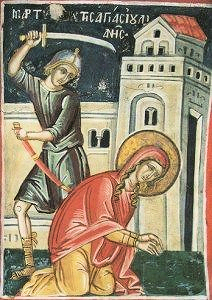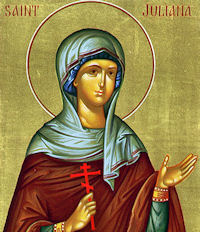Lent: February 16th
Wednesday of the First Week of Lent
Other Commemorations: St. Juliana, Virgin and Martyr (RM)
» Enjoy our Liturgical Seasons series of e-books!
"This is a wicked generation; it is asking for a sign. The only sign it will be given is the sign of Jonah. For just as Jonah became a sign to the Ninevites, so will the Son of Man be to this generation."
In the Roman liturgical tradition, the Wednesdays and Fridays of Lent were times of special prayer. But the Wednesday, Friday, and Saturday after the First Sunday of Lent, called Ember Days, were marked by an increase in the number of readings and prayers in the liturgy. Parenthetically, it may be noted that Ember Days occurred not only in Lent, but at three other times in the year. Despite the fact that the season of Lent has undergone some major adjustments in theology and piety, it is clear that today's liturgy has aspects which are directly derived from the Ember Days tradition. The entrance antiphon and opening prayer for today are taken from the Mass formula in use until the present reform, thus indicating perduring elements from the Ember Wednesday tradition.
The first reading from the prophet Jonah (3:1-10), with its reference to "ashes and sackcloth," adds to the serious and penitential tone of the liturgy today. In the perspective of what has already been celebrated this week, today's liturgy is in continuity because Jesus is portrayed in the gospel as referring to the "sign of Jonah," and calling "the crowds" to repentance (Luke 11:29-32).
The opening prayer, taken from the second collect for the Ember Day Mass in the Roman Missal, is traditional for this day. The present translation, "help us to discipline our bodies and to be renewed in spirit," is adequate, yet the sense of the Latin original gives greater emphasis to the discipline of bodily abstinence that will bear fruit and renew us in spirit. Formerly, church law imposed fasting and abstinence, especially in Lent. Today the requirements are more lenient, but the liturgy still emphasizes that works of penance have an important spiritual effect.— A Guide to the Eucharist and Hours - Lent by Kevin W. Irwin
| Today's Station is at St. Mary Major. The spring Ember Week consecrated the new season to God and by prayer and fasting sought to obtain abundant graces for those who on Saturday were to receive Holy Orders. The Station was fittingly held in the church, which witnessed the first scrutinies for the coming ordinations, and which was dedicated to the mother of the great High Priest. |  |
Confidence and Union with God in Temptation
Nothing is more efficacious against temptation than the remembrance of the Cross of Jesus. What did Christ come to do here below if not to "destroy the works of the devil"? And how has He destroyed them, how has He "cast out" the devil, as He Himself says, if not by His death upon the Cross?
Let us then lean by faith upon the cross of Christ Jesus, as our baptism gives us the right to do. The virtue of the cross is not exhausted. In baptism we were marked with the seal of the cross, we became members of Christ, enlightened by His light, and partakers of His life and of the salvation He brings to us. Hence, united to Him, whom shall we fear? Dominus illuminatio mea et salus mea; quern timebo? Let us say to ourselves: "He hath given His angels charge over thee to keep thee in all thy ways."
"Because he hoped in Me (says the Lord) I will deliver him; I am with him in tribulation, I will deliver him, and I will glorify him. I will fill him with length of days, and I will show him My salvation." — Dom Marmion, Christ the Life of the Soul
St. Juliana of Nicodemia
 St. Juliana suffered martyrdom during the Diocletian persecution. Both the Latin and Greek Churches mention a holy martyr Juliana in their lists of saints. The oldest historical notice of her is found in the "Martryologium Hieronymianum" for 16 February, the place of birth being given as Cumae in Campania (In Campania Cumbas, natale Julianae). It is true that the notice is contained only in the one chief manuscript of the above-named martyrology (the Codex Epternacensis), but that this notice is certainly authentic is clear from a letter of St. Gregory the Great, which testifies to the special veneration of St. Juliana in the neighbourhood of Naples. A pious matron named Januaria built a church on one of her estates, for the consecration of which she desired relics (sanctuaria, that is to say, objects which had been brought into contact with the graves) of Sts. Severinus and Juliana. Gregory wrote to Fortunatus, Bishop of Naples, telling him to accede to the wishes of Januaria (Gregorii Magni epist., lib. IX, ep. xxxv, in Migne P.L., LXXXVII, 1015).
St. Juliana suffered martyrdom during the Diocletian persecution. Both the Latin and Greek Churches mention a holy martyr Juliana in their lists of saints. The oldest historical notice of her is found in the "Martryologium Hieronymianum" for 16 February, the place of birth being given as Cumae in Campania (In Campania Cumbas, natale Julianae). It is true that the notice is contained only in the one chief manuscript of the above-named martyrology (the Codex Epternacensis), but that this notice is certainly authentic is clear from a letter of St. Gregory the Great, which testifies to the special veneration of St. Juliana in the neighbourhood of Naples. A pious matron named Januaria built a church on one of her estates, for the consecration of which she desired relics (sanctuaria, that is to say, objects which had been brought into contact with the graves) of Sts. Severinus and Juliana. Gregory wrote to Fortunatus, Bishop of Naples, telling him to accede to the wishes of Januaria (Gregorii Magni epist., lib. IX, ep. xxxv, in Migne P.L., LXXXVII, 1015).
The Acts of St. Juliana used by Bede in his Martyrologium are purely legendary. According to the account given in this legend, St. Juliana lived in Nicomedia and was betrothed to the Senator Eleusius. Her father Africanus was a pagan and hostile to the Christians. In the persecution of Maximianus, Juliana was beheaded after suffering frightful torturers. Soon after a noble lady, named Sephonia, came through Nicomedia and took the saint's body with her to Italy, and had it buried in Campania. Evidently it was this alleged translation that caused the martyred Juliana, honoured in Nicomedia, to be identified with St. Juliana of Cumae, although they are quite distinct persons. The veneration of St. Juliana of Cumae became very widespread, especially in the Netherlands. At the beginning of the thirteenth century her remains were transferred to Naples. The description of this translation by a contemporary writer is still extant. The feast of the saint is celebrated in the Latin Church on 16 February, in the Greek on 21 December. Her Acts describe the conflicts which she is said to have with the devil; she is represented in pictures with a winged devil whom she leads by a chain.
—Excerpted from The Catholic Encyclopedia
Patronage: against bodily ills; sick people; against sickness
Symbols and Representation: young woman battling a winged devil; young woman being boiled; young woman chaining up a dragon; young woman chaining up and/or scourging the Devil; young woman in a cauldron; young woman leading a chained devil; young woman standing or sitting on a dragon; young woman wearing a crown on her head and a cross on her breast; naked young woman hanging by her hair
Highlights and Things to Do:
- Read more about St. Juliana:
- See the statue of St. Juliana in the Colonnade of St. Peter's Basilica.






